Tiptop Audio Grain de Folie Handleiding
Tiptop Audio
Niet gecategoriseerd
Grain de Folie
Bekijk gratis de handleiding van Tiptop Audio Grain de Folie (6 pagina’s), behorend tot de categorie Niet gecategoriseerd. Deze gids werd als nuttig beoordeeld door 93 mensen en kreeg gemiddeld 5.0 sterren uit 47 reviews. Heb je een vraag over Tiptop Audio Grain de Folie of wil je andere gebruikers van dit product iets vragen? Stel een vraag
Pagina 1/6

Grain de Folie
Granular Effects for Tiptop Audio Z-DSP

Grain de Folie - Granular Eects for Tiptop Audio Z-DSP
Background:
Granular Synthesis uses small slices of sounds (‘grains’) to compose new sounds from existing
material. By combining multiple grains of diering lengths, amplitude, pitch and speed creates
very characteristic sounds of modern music.
Xenakis claims to have invented the technique and indeed his ‘Analogique A-B’, composed of
tiny tape splices of pure tones, is credited as the rst piece of granular music in 1959. Tape
editing proved extremely time consuming, but by the 1970s digital processing could take the
place of tape splicing. Curtis Roads dove into the early computer based granular synthesis and
made some of the classic techniques known through his recordings, teaching and texts like
‘Microsound’. Today, most computer audio programs have some sort of granular synthesis
engine or plugin. Dr. Richard Boulanger has used granular synthesis in CSound to great eect
and he is also a beta tester for this card.
The French phrase for the cartridge is "Grain de Folie" which could be translated as "seeds of
madness", but in French "grain" also translates to "grain", and "madness" evokes the strange
disassembling/reassembling granular process. Also, "avoir un grain de folie" is a typically
French expression to describe people behaving in a non conventional way, thus a tting play on
words.
How it works:
Granular processing requires a block of memory to hold digital samples for playback, and the
Z-DSP has one second of memory for the audio used in processing. From this audio buer the
grains will sample smaller sections for playback.
The number of grains in the process determine how dense the overall output sounds. These
programs have 3, 4 or 6 grains for playback. Each grain plays from a random point in the audio
buer and have an independent envelope controlling their duration. The envelope time is the
‘grain size’ parameter in many of the programs.
In the context of the Z-DSP, the FV1 (the DSP brain) is really not designed for grain synthesis
(due to technical choices like a "circulating" delay memory, and the lack of indirect memory
access), but the chip also has other design niceties that help overcome its limitations…
This cartridge implements a simple and customised granular synthesis with a limited number of
grains, and parameters that mainly control the size of grains and their positions in the sample.
One nice aspect of the Z-DSP is that it uses live inputs (granular synthesis is usually based on a
pre-recorded sample), so it can disassemble live input and reassemble it in real-time into a
dierent order resulting in a (usually !) nice sonic transformation of both texture and the
rhythm.

Controls:
The left control knob and CV input has the same function on each program and controls how
audio is sampled into the granular process. There are four sections of this control:
O - Live input processing. Audio is continually fed through the delay line.
1-25% - Freeze buer. No audio is input to the buer delay line.
26-100% - Audio is put back into the buer from the grains. The higher the level the more
audio is fed back. High levels tend to create glitches in the output as it fades into nothing.
NOTE: When a program is changed or the Z-DSP powers on there is no audio in the buer
to Freeze, and no sound will be output. The Freeze+ control MUST be at 0 for a short time
to process any audio before freezing!
Programs:
1> Four Spread Grains 1
Four independent grains have a random playback position with control over the
length of each grain and the randomness of the position. Two grains are sent to
Left output and the other two to the Right creating a spatial spread.
VC-DSP1 - Live / Freeze / Feedback. See the Control section above
VC-DSP2 - Grain size. Sets the maximum size of the grain.
VC-DSP3 - Spread. Grain Dispersion.
2> Four Spread Grains 2
Four independent grains have a random playback position with control over the
length of each grain and the randomness of the position. The grains all have the
same size which lessens the stereo spread. This program is very useful for
rhythmic processing.
VC-DSP1 - Live / Freeze / Feedback. See the Control section above
VC-DSP2 - Grain size. Sets the maximum size of the grain.
VC-DSP3 - Spread. Grain Dispersion.
3> Pitch Modulated Grain1
Four independent grains have a random playback position with control over the pitch of
each grain (LFO modulates the pitch). Two grains are sent to Left output and the other
two to the Right creating a spatial spread.
VC-DSP1 - Live / Freeze / Feedback. See the Control section above
VC-DSP2 - Grain size. Sets the maximum size of the grain.
VC-DSP3 - Pitch. The amount of pitch shift applied to the grain
Product specificaties
| Merk: | Tiptop Audio |
| Categorie: | Niet gecategoriseerd |
| Model: | Grain de Folie |
Heb je hulp nodig?
Als je hulp nodig hebt met Tiptop Audio Grain de Folie stel dan hieronder een vraag en andere gebruikers zullen je antwoorden
Handleiding Niet gecategoriseerd Tiptop Audio
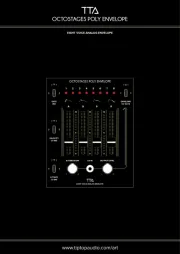
5 Augustus 2025
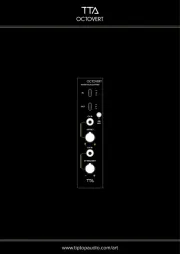
5 Augustus 2025
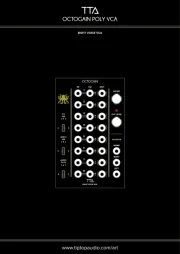
4 Augustus 2025
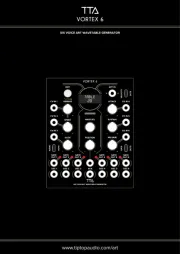
4 Augustus 2025
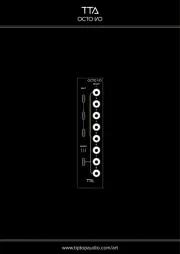
18 Maart 2025

18 Maart 2025

30 Januari 2025

3 Augustus 2023

5 Mei 2023

18 April 2023
Handleiding Niet gecategoriseerd
- REVITIVE
- Estella
- AutoParkTime
- Maxdata
- Waveplayer Systems
- Bellelli
- TCL
- Herkules
- Mirpol
- Master Lock
- Rindor
- Arturia
- GoDEX
- Ariston Thermo
- Ordo
Nieuwste handleidingen voor Niet gecategoriseerd

14 September 2025

14 September 2025

13 September 2025

13 September 2025

13 September 2025

13 September 2025

13 September 2025

13 September 2025

13 September 2025

13 September 2025